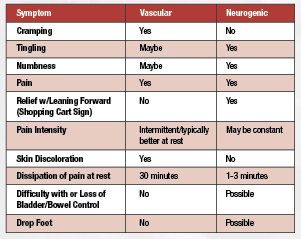By Jeffrey R. Carlson, MD, CPE
When muscles don’t get enough blood flow due to obstructed arteries, cramping pain can result simply from walking or using one’s arms. Vascular claudication (VC) is a condition typically caused by peripheral artery disease and is a debilitating problem that worsens over time. Cardiologists consult with patients to determine if their claudication is caused by blood flow issues resulting from cardiac insufficiency. If, after rigorous examination and testing, they find no or little evidence of cardiac or vascular involvement, they may suspect a spine related issue is at play and refer their patient to an orthopaedic spine specialist for evaluation.
Neurogenic claudication or pseudo-claudication are terms that refer to claudication caused by nerve compression in the lumbar spine. Some of the symptoms are like VC, but many are different, as you can see in the table below:
By doing a thorough physical examination, diagnostic imaging and asking specific questions designed to tease out these differences, a specialist can diagnose neurogenic claudication caused by conditions such as spinal stenosis, a bulging or herniated disc, spondylolisthesis, degenerative disc disease, or a combination of these.
Treatment usually starts conservatively unless neurologic signs are troubling, such as drop foot or loss of bowel or bladder control. That usually means starting with anti-inflammatory medications, physical therapy and activity modification. If the nerve root(s) remain irritated after several weeks, an epidural steroid injection (ESI) may be considered to get the medication exactly at the pain generator. After the ESI, physical therapy becomes more effective and less painful for the patient.

Surgery may be considered if this conservative treatment continues to provide little to no pain relief for the patient. Depending on the mechanical issue, like a spondylolisthesis, a fusion may be needed for stability. Bone spurs might need to be cleaned out to provide more space in the spinal canal to relieve pressure on the spinal cord and nerve roots by doing a laminectomy. Sometimes, several complex procedures are required to address multiple spinal issues, such as arthritis, a herniated disc and facet joint problems.
With today’s advanced technology, anesthesia and minimally invasive surgical techniques, spine surgery can mostly be done in an outpatient setting so the patient can go home the same day to recover in their own bed. With supportive in-home nursing and PT, surgical patients with neurogenic claudication often do very well in recovery. Nerve compression injury typically takes time to heal; however, many patients recover with no lingering effects.

Dr. Jeffrey Carlson joined Orthopaedic & Spine Center in 1999 and serves as the President and Managing Partner. He is a Board certified, fellowship-trained orthopaedic spine surgeon who focuses on the treatment of injuries and disorders of the spine. osc-ortho.com

